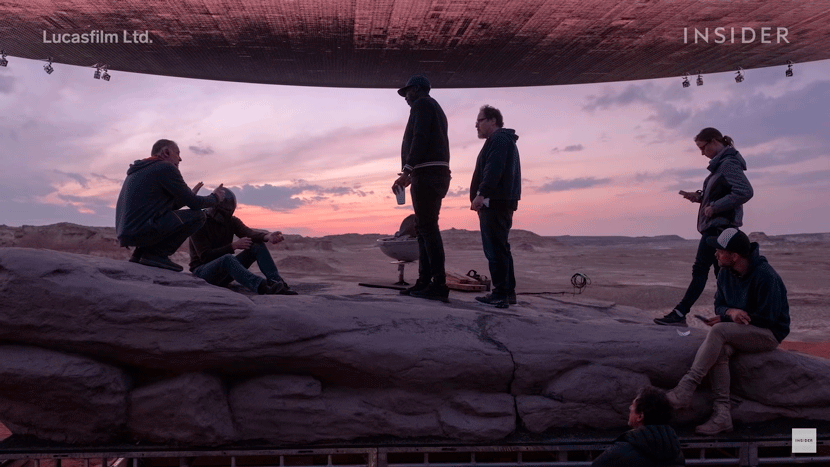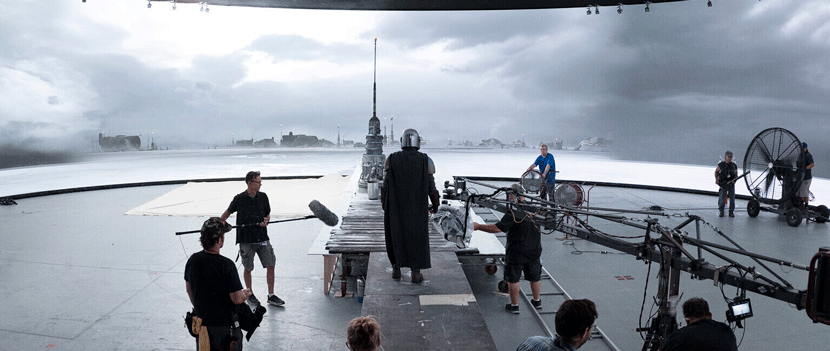In the world of filmmaking and television, storytelling is a complex art that continually changes to engage audiences in creative ways. Throughout time, directors, producers, and cinematographers have explored different methods to involve viewers deeply in their stories, resulting in unforgettable experiences.
Among these techniques, the "Volume Technology" has emerged as a captivating visual 3D controlled space creating 3D modeling scenarios for films and TV series to replace the famous green screen. In this article below, we will explore the history and techniques of the Volume Technology in films and TV series. We will delve into how this approach has transformed storytelling and its impact on audiences worldwide.

The scene is developed within a controlled environment, it is feasible to create extremely detailed and realistic environments. (Source by Youtube.com/@Insider)
How does the Volume Technology work in films and TV series?
The Volume Technology in filmmaking encompasses various related techniques, that enhance the visual experience for the actors and the audience. Here are some notable examples:
- IMAX Dome: This technique utilizes a fisheye lens to capture a highly distorted 180° field of view onto IMAX film. The bottom portion of the circular field falls beyond the film's edge and is masked, creating an immersive projection within dome theaters.
- StageCraft: StageCraft is a cutting-edge technique in productions like "The Mandalorian." It involves shooting actors and sets surrounded by LED video walls displaying computer-generated backdrops. This enables real-time manipulation of the virtual environments and allows for dynamic and interactive filming.
- Cinematography: Cinematography refers to the art of capturing images using a camera in filmmaking. It involves making deliberate decisions about camera angles, movement, framing, lighting, and other visual elements to convey meaning and evoke emotions in a film or animation.
- Encore VFX: A reputable visual effects firm called Encore VFX has greatly impacted several TV shows, including "Under the Dome" and "Falling Skies." Their area of expertise is creating and flawlessly integrating visual effects that raise the production's storytelling and increase its aesthetic attractiveness.
- Fulldome.pro: Fulldome.pro is a company specializing in creating content, specifically designed for dome theaters. They offer a range of services, including content creation, animation, and projection systems tailored to the unique requirements of dome theaters.
These techniques and technologies exemplify the innovative approaches taken in the Volume Technology and the wider field of filmmaking. By leveraging advanced tools, visual effects, and creative methodologies, filmmakers can deliver captivating and immersive experiences for both the actors and the audience.
Volume Technology builds immersive 3D environments within a controlled space
The Volume Technology's ability to offer a high level of 3D space control is one of its main advantages. In simple words, The Volume Technology is a 3D-controlled space, the background can change every time they want because it's a 3D background model design. The scene is developed by 3D designers within a controlled environment.
It is feasible to create extremely detailed and realistic environments that would be challenging or impossible to find and build in the actual world. This makes it a powerful tool for creating immersive experiences in a variety of applications, from film and television production to theme park attractions and immersive art installations.
Allows actors to immerse themselves fully in the scene
By projecting the environment onto the dome screen, actors can interact with the 3D modeling background so they can see the environment. This leads to more authentic performances and a more engaging experience for the audience because the actor finds himself in the scene and can see the surroundings on the screens instead of acting in front of a green screen.
In addition, IMAX Dome theaters employ a unique projection system that involves using a specialized camera equipped with a fisheye lens. This lens captures a highly distorted anamorphic 180° field of view onto a 65 mm IMAX film. The lens is positioned below the center of the frame, resulting in most of the bottom half of the circular field extending beyond the film's edge.
Volume Technology: The ability to visualize 3D scenes in real-time
The 3D Modeling used in The Volume Technology can cover a large field of view, allowing for a more encompassing visual experience. To achieve the Volume Technology, specialized software, and hardware are used, even a render farm. Rendering engines play a crucial role in generating computer-generated imagery (CGI) on the fly. These rendering engines can quickly process complex 3D scenes and render them in real-time, taking into account lighting, textures, and other visual effects.
We, at RebusFarm offer cloud rendering services and an Unlimited Render Rental Service with which you can rent your own server to render online on our render farm. In your period of rental, the machines are available only for you 24 hours per day. Get started with a free trial to test our service without any obligations.
Real-time rendering engines and LED panels
In the Volume Technology, real-time rendering engines generate CGI and project them onto the dome screen. They take care of geometry, textures, lighting, and visual effects, all in real-time. This means that the CGI content projected onto the dome screen will not be seen blurred or out of space like green screens do and the 3D modeling in the background is generated and rendered instantly, resulting in a seamless and immersive visual experience for the audience. The real-time nature of these engines allows for immediate feedback and interactivity, enhancing overall engagement and immersion.
LED panels are commonly used in dome theaters. They offer high brightness, excellent color reproduction, and energy efficiency. Arranged in a curved shape matching the dome, they provide a uniform and immersive visual display.
Volume Technology: Cost and time savings
The Volume Technology offers significant cost and time savings in various aspects of the production. It reduces expenses and streamlines the production process by utilizing real-time rendering engines, 3D modeling and the LED panel technology. In the Mandalorian TV series for example, they make use of the technology. So instead of having to travel to another country with all the equipment to film different scenes with different settings, all they have to do it change the screen backgrounds and they are in a new setting with a few clicks.

3D controlled space for filmmaking and TV series production.
Production travel costs, set construction expenses, and post-production rendering
The Volume technology allows filmmakers to hire 3D designers to create all the 3D modeling in the background mixed with sound editing, controlled in a 3D space, so you don't have any disruption to worry about in post-production. Additionally, virtual environments and 3D scenes can be created and rendered in real-time, eliminating the need for expensive travel arrangements and logistics.
Next to that, set construction expenses are minimized. Traditional physical sets can be costly to build and maintain, requiring materials, labor, and storage space. By generating virtual sets through real-time rendering engines, the need for physical construction is significantly reduced, resulting in substantial savings.
Post-production rendering is another area where the Volume Technology offers cost and time efficiencies. To generate high-quality visuals, traditional rendering processes often require significant computational power and time. With real-time rendering engines, the rendering is done in real-time, eliminating the need to film the entire scene then put the VFX on it, editing which at the end reduces post-production costs with less time spend in this process.
Volume Technology offers tremendous versatility and creativity
Filmmakers can create visually stunning and immersive experiences that immerse the audience in the heart of the narrative. Whether exploring distant planets, diving into underwater realms, or journeying through historical events, this technology enables the seamless and lifelike depiction of these fictional worlds.
It empowers filmmakers to create new narratives. The Mandalorian season one, for example, began as a Western show in the desert and evolved into a space action show by going through different environments, visual styles, and storytelling techniques, ultimately enhancing audiences' overall cinematic and immersive experience, replacing the green screen.
Conclusion
The Volume Technology represents a paradigm shift in visual storytelling, allowing for the creation of immersive narratives that transport audiences into extraordinary worlds. With its ability to generate real-time CGI, render farm tricks, and synchronize it with LED panels, this technique opens up new possibilities for filmmakers and TV series creators.
It helps them to captivate viewers and deliver unforgettable cinematic experiences and truly transforms the future of storytelling. We can expect to see its continued innovation and impact in the world of films and TV series.

About the author
Nicole Holt is an experienced 3D enthusiast with a career in marketing and content writing. Thanks to this unique combination, she is able to showcase the technical intricacies of 3D art and rendering while also making the subject accessible to a wide audience. When she's not immersed in the digital world, Nicole can be found in the great outdoors, most likely with her beloved dog, Sammy.
